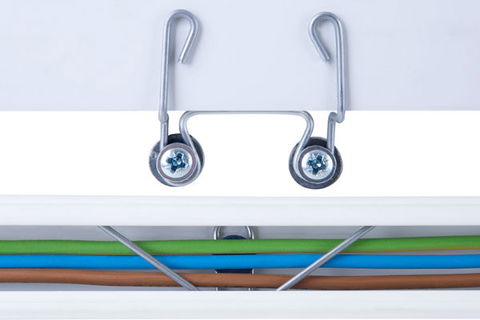Nick Hayler, Marshall-Tufflex Technical Services Manager, provides an overview of the cable management brand's award-winning, fire-resistant, cable clip and explains how it will help contractors comply with BS 7671.

The fire performance of cable management systems is becoming an increasingly important debate, not least because BS 7671:2008 of the Wiring Regulations (Amendment 3) requires wiring systems above escape routes to be supported by fire-resistant fixings and fastenings to prevent cables collapsing in extreme heat.
Escape times and keeping escape routes clear are both critical factors. It has been recognised that falling or hanging cables can pose a major safety hazard to building occupants and firefighters in the event of a blaze, with 14 deaths attributed to cable entrapment between 2004 and 2014, hence the amended regulations.
It is a sensible move, intended to keep designated escape routes clear of fallen or hanging cables, enabling building occupants to leave safely and for firefighting teams to access the building in the event of a blaze. Importantly the regulations are not prescriptive, permitting specifiers and installers an amount of freedom in choosing the best way to ensure they are complied with. This allows for a full range of cable management solutions and materials to be considered and normal specification drivers – practicalities, aesthetics, ease of installation, availability and cost – to remain important elements of the decision-making process.
It is completely in line with the current IET regulations to use a suitable fire resistant means of supporting cables in PVC-U trunking in the event of fire. Marshall-Tufflex, as the UK’s market-leading cable management manufacturer, offers a vast range of solutions in a variety of materials, from PVC-U to GRP, aluminium and steel. Nine times out of 10 we find that one of our 38 PVC-U systems fits the installation specification perfectly. And for this reason, it was incredibly important to us to offer a trusted and reliable fastening solution to meet the requirements of BS 7671:2008+A3:2015.
That solution is the Firefly fire clip, an easy-to-install and straight-forward way to protect against premature cable collapse should fire break out. Spring-loaded Firefly clips fit on the inside or outside of Marshall-Tufflex mini/maxi trunking and conduit, holding cables secure in the event of a fire to ensure escape routes remain free and accessible (the clips embed themselves tighter into substructure as a fire takes hold, making it almost impossible for overhead cables to fall). They are fire resistant above 1,000°C for up to 120 minutes, far exceeding the requirements of 45 minutes at 930°C. Installation of Firefly clips satisfies regulations prohibiting the use of non-metallic clips or plastic trunking as the sole means of support for cables.
Firefly clips can be fixed to walls and ceilings, are quick and easy to install and do not reduce usable space for cables. The internal version fits within trunking prior to cable installation; the external version can be retrofitted. Firefly clips are also available in kits which include specifically designed, fully compliant fixings for either masonry or cavity walls. It is very important to remember that the fixings are vital and should not be overlooked. Using the correct fixings for the substrate is essential to stop premature collapse. Firefly kits offer this full solution, which still allows for faster installation times than using metal systems.
This bespoke solution delivers a quick and easy way to meet the regulations and provide a safe installation. Firefly has recently been awarded eight Warringtonfire safety certificates following tests using Prysmian Plus fire alarm cable. The clips also won ‘Industrial Product of the Year’ in the prestigious Electrical Industry Awards 2017.
The only question that then remains is the definition of ‘escape routes’, of which there are currently two:
- BS 7671:2008+A3:2015: Path to follow for access to a safe area in the event of an emergency.
- The Building Regulations Document B: Route forming that part of the means of escape from any point in a building to a final exit
The next edition of the Wiring Regulations, due for publication this year, will aim to clear up confusion.

PVC-U fire performance
But what of the PVC-U cable management itself? How does it behave when subjected to fire? A number of factors should be taken into account when assessing fire risk:
- Time to ignition
- Burning rate
- Heat release
- Smoke production
- Toxicity
PVC-U is proven to be highly resistant to ignition and does little to contribute to the spread of fire, affording it a Building Regulations Class 0 rating. It also acts as an effective barrier to the spread of flame from malfunctioning electrical components contained within, has a low rate of smoke production during the early stages of a fire, does not produce flaming droplets and - importantly - chars, making it self-extinguishing.
In short, PVC-U is inherently flame retardant, requiring an external heat source to continue combustion. When subject to a fire situation, the material has low combustion heat, a low burning rate and limited amounts of toxic gases; its resistance to ignition and low rate of heat release means that it makes a minimal contribution to fire development and growth. These qualities give it an excellent fire rating.
But these inherent qualities are no longer sufficient for the demands of modern buildings and tightening building controls. Specifiers and installers are increasingly being asked to give further consideration to how cable management installations can play their part in making buildings safer in the event of a fire.
Conclusion
PVC-U is a proven and excellent building material that stands the test of time. As demonstrated its fire performance is classified to Building Regulations Class 0 and it is 100% recyclable. Through industry self-regulation and the work BEAMA (the British Electrotechnical and Allied Manufacturers' Association) and standards agencies carry out, products are continually undergoing ever more rigorous testing to ensure their fitness for purpose.
For more information on the cable management solutions from Marshall-Tufflex, click here.
